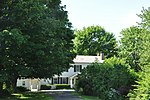Sharpe Homestead and Cemetery
Houses completed in 1740Houses in Rensselaer County, New YorkHouses on the National Register of Historic Places in New York (state)National Register of Historic Places in Rensselaer County, New YorkRensselaer County, New York Registered Historic Place stubs

Sharpe Homestead and Cemetery is a historic home and cemetery located at Defreestville in Rensselaer County, New York. The house was built about 1740 and is a 1+1⁄2-story rectangular frame dwelling, 20 feet by 40 feet, topped by a steeply pitched gable roof covered with standing seam metal. It rests on a low fieldstone foundation. The family cemetery contains approximately a dozen stones marking the graves of the Sharpe and Barringer families.It was listed on the National Register of Historic Places in 2005.
Excerpt from the Wikipedia article Sharpe Homestead and Cemetery (License: CC BY-SA 3.0, Authors, Images).Sharpe Homestead and Cemetery
Stonegate Drive, Town of North Greenbush
Geographical coordinates (GPS) Address Nearby Places Show on map
Geographical coordinates (GPS)
| Latitude | Longitude |
|---|---|
| N 42.661111111111 ° | E -73.699166666667 ° |
Address
Stonegate Drive
Stonegate Drive
12144 Town of North Greenbush
New York, United States
Open on Google Maps







